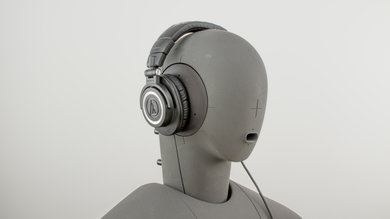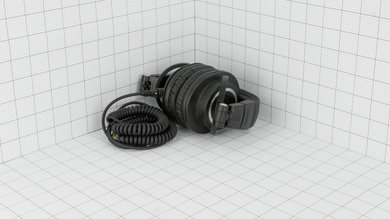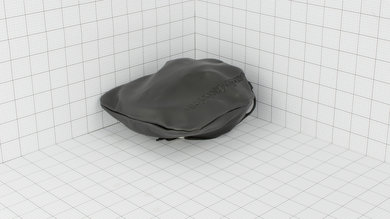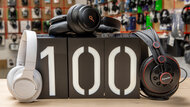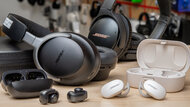The Audio-Technica ATH-M50x are closed-back, over-ear headphones. The manufacturer has a reputation for making well-built products that are well-suited for both professional and home use. Thanks to their closed-back design, comfortable fit, and detachable cable, these headphones are a versatile choice for a variety of listening applications, and they remain a mainstay in studios around the world.
Our Verdict
The Audio-Technica ATH-M50x are disappointing for sports. They have a decently comfortable design, but they're a bit too bulky and unstable for sports. They also have a thick audio cable with no control scheme to change tracks while working out.
- Sturdy and comfortable build.
- Detachable audio cable.
- Prone to leakage at higher volumes.
- Poor noise isolation performance.
- No buttons or audio control options.
The Audio-Technica ATH-M50x are inadequate for travel. They only block noise passively, which won't be enough for the noisy environments involved in commuting. They're also too bulky to carry around on your person at all times and have no control scheme to change tracks on the go.
- Sturdy and comfortable build.
- Prone to leakage at higher volumes.
- No buttons or audio control options.
Disappointing frequency response consistency.
The Audio-Technica ATH-M50x are disappointing for office use. They don't leak too much audio but might be audible to the people around you at higher volumes. Unfortunately, they also don't block enough noise to use in noisy environments, so you'll hear the ambient chatter and scraping chairs of a lively office.
- Sturdy and comfortable build.
- Prone to leakage at higher volumes.
- Poor noise isolation performance.
Disappointing frequency response consistency.
These headphones can only be used wired, so they're not suitable for wireless gaming.
The Audio-Technica ATH-M50x are passable for wired gaming, so long as you own a standalone mic. Their wired connection ensures a virtually latency-free gaming experience. These comfortable headphones also have extra boom for a more immersive experience and balanced mids, ensuring that dialogue and instruments sound clear and accurate in cinematic cut scenes. You may need to adjust their fit between gaming sessions to ensure you get a consistent sound.
- Sturdy and comfortable build.
- Detachable audio cable.
- Poor noise isolation performance.
Disappointing frequency response consistency.
The Audio-Technica ATH-M50x are okay for audio reproduction accuracy. Their frequency response mostly follows their balanced sound profile, with most deviations occurring in the bass range. There are a few factors responsible for this, such as the inconsistencies in audio delivery caused by their rigid design and a phase cancellation in the mid-bass range. This phase cancellation also translates to a poor group delay performance. While this means transients in the bass range aren't as well-defined as they could be, the rest of the frequency response is generally balanced, meaning vocals and instruments are clear and natural-sounding. Overall, their frequency response complies well with our target curve.
The Audio-Technica ATH-M50x have a disappointing noise isolation performance. While their closed-back design provides some passive isolation against treble-range frequencies, it does very little to prevent bass and mid-range noises from interfering with your audio. As a result, you'll be able to hear noises like engine rumble; be they from planes, trains or automobiles, as well as mid-range noises like background conversations.
The Audio-Technica ATH-M50x lack a built-in microphone.
The Audio-Technica ATH-M50x's frequency response consistency is sub-par. The rigid headband and bulky earcups can result in some deviations in bass-range delivery, meaning the bass response is generally stronger in the right channel than the left. If you have long hair, this can disrupt the seal formed over your ears, too, resulting in more deviations in bass delivery between reseats. The response is generally more consistent across the mid and treble range, though.
Performance Usages
Changelog
- Updated Jul 29, 2025:
We've updated the Sound Profile box with a link to a downloadable folder of EQ settings that will help you match these headphones' frequency response to different target curves available in our Graph Tool.
- Updated May 21, 2025:
The Bass Profile: Target Compliance was updated to mention the FIIO FT1.
- Updated Apr 25, 2025:
This review has been updated to Test Bench 2.0, which adds the following tests: Stereo Mismatch, Group Delay, Cumulative Spectral Decay, PRTF, Harmonic Distortion, and Electrical Aspects. We've added new performance usages and updated the text throughout the Sound tests and side-by-sides.
- Updated Apr 25, 2025: We've converted this review to Test Bench 2.0, which updates our sound tests and adds performance usages. You can read more about this in our changelog.
Check Price
Differences Between Sizes And Variants
The Audio-Technica ATH-M50x come in two color variants: 'Black' and 'White'. The manufacturer holds a poll every year to pick a new limited edition colorway, so you might see other colors like 'Ice Blue,' 'Purple and Black,' 'Deep Sea Blue' and 'Lantern Glow' available new or on the secondhand market. We tested the 'Black' variant, but we expect all colorways to perform similarly. If you encounter another variant of these headphones, please let us know in the comments, and we'll update our review.
Popular Headphones Comparisons
The Audio-Technica ATH-M50x are closed-back headphones well-suited for both audiophiles and audio professionals. Their closed-back design and sturdy construction resemble the Beyerdynamic DT 770 PRO. The Audio-Technica have a conveniently detachable audio cable, but otherwise, preferences between the two in terms of sound and comfort will come down to personal taste. The manufacturer also offers other headphones in the same series to suit a range of budgets, like the Audio-Technica ATH-M40x, which offer a similar design and fit at a more wallet-friendly price. That said, they don't sound as neutral, and their build quality isn't as good. Audio-Technica has also since released a Bluetooth-equipped, wireless variant: the Audio-Technica ATH-M50xBT2. While they're more portable and feature an integrated mic, they lack the wired version's boomy bass. For more, check out our recommendations on the best Audio-Technica headphones.
If you're interested in other brands, see our articles on the best headphones for music, the best DJ headphones, and the best headphones for studio use.
The Audio-Technica ATH-M50x and Sony MDR-7506 are similar headphones targeted toward professional and studio use. The Audio-Technica are more comfortable to wear during long listening sessions, and they feel better built than the Sony MDR-7506. Both are tuned for monitoring and recording audio. The headphones are fairly similar, but you might be able to find the Sony at a cheaper price point, so they might offer better value, even though the Audio-Technica include swappable cables for easy replacement.
The Audio Technica ATH-M50x are very similar to the Audio Technica M40x, but they have a slight edge over them. They feel a bit sturdier and better-built than the M40x. Both headphones will give you great sound and are also great options for critical listening, but the M50x offer one of the best values on the market due to their great price-to-performance ratio.
While the Audio-Technica ATH-M70x are more comfortable than the Audio-Technica ATH-M50x, they might not be the better choice for most people. The M50x are more affordable, meaning they'll offer great value for most people. The two headphones are very similar and the extra investment necessary for the M70x might not be worth it.
The Audio Technica ATH-M50x and the Beyerdynamic DT 770 PRO have very similar performance, but some might prefer the better build quality of the Beyerdynamic. Their metal frame feels sturdy, and the soft padding fabric feels nice on the skin. However, they can be tight for some, especially if you have a larger head. They might also sound a bit sharp for some and don't come with as many cable options as the Audio Technica.
Test Results

The Audio-Technica ATH-M50x have a balanced sound profile. However, the rigid design of the headband makes it difficult to achieve consistent audio delivery between the left and right channels, resulting in some amplitude mismatch in the bass range.
If you'd like to tweak the headphones' frequency response to more closely match one of the target curves found in our Graph Tool, check out our downloadable EQ parameters folder.
The frequency response consistency is sub-par. Bass range delivery in particular can vary quite a bit depending on your head size and facial features, due to the rigidity of the headband. In most cases this makes for a strong bass response in the right channel, compared to the left. Users with long hair will also notice more inconsistencies in the bass response between different reseats. Consistency is a little better in the mid and treble range, but you'll still need to ensure you adjust the fit to ensure optimal audio delivery.
They have excellent bass target compliance. While there's some deviation between the response in the left and right channels in this range, due to inconsistencies created by their rigid headband and shallow ear cups, the response delivers ample boom and fullness to kick drums and bass guitars. Deep synths are comparatively a bit lighter on the low rumble in tracks like Aerodynamic by Daft Punk, due to a phase cancellation in the mid-bass, but still sound prominent. If you use these headphones for wired gaming, this bump in the high-bass can also help bring out the sound of footsteps. On the other hand, if you want a thumpier bass response, the FIIO FT1 can deliver a more even and heftier low- and mid-bass.
The mid-range target compliance is amazing. Overall, the response is fairly neutral across the entire range. As a result, vocals and lead instruments are generally present and detailed. A small dip in the low-mid makes lead instruments sound a little thin, but the rest of the mids are fairly even, if a touch elevated, in the high-mids to intensify vocals slightly.
Their treble's target compliance is outstanding. The lower half of the low-treble is quite balanced and produces clear vocals. There are some deviations from our target in the mid-treble that can cause sibilants to vary in their brightness, but it's hard to pick up unless you're an astute audiophile. These slight deviations carry through to the high-treble, though we lose sensitivity to this range over time.
These headphones have a good peaks and dips performance. They follow their own balanced sound profile for the most part, with narrow deviations. Due to the rigid design of the headphones and the difficulty getting an adequate seal over your ears, there's some deviation between left and right in the bass response. That said, the bass is overall somewhat flat, except for sharp dips that reduce the rumble of sub-bass synths, and a gradual over-emphasis in the higher bass regions adds extra punch to kicks. A narrow notch in the low-mids declutters the bloat of the high-bass a bit, while the rest of the mids are rather even for balanced-sounding leads. The treble range sees a series of narrow peaks and dips which result in uneven sounding vocal harmonics and cymbals, that come across as either overly bright, shrill, or a somewhat muffled and veiled in the details.
These headphones have a poor stereo mismatch performance. The difficulty in achieving a solid fit means there's some frequency response mismatch in the bass range, so mid and high-bass frequencies sound louder in the left channel. While the L/R drivers are well-matched across the rest of the frequency range, the deviations in the bass range mean there is an audible amplitude mismatch between them. There are some mismatches in phase, too, most notably in the bass range and the low-mid, where there are audible cancellations that are reflected in the frequency response.
The group delay performance is terrible. Our group delay tests show a negative phase shift in the low and mid-bass regions. This translates to a resonance clearly visible in the frequency response graph. As a result, bass frequencies lack tightness, with transients that lack clear definition.
The PRTF performance is decent, especially compared to other closed-back headphones. There's a non-negligible amount of interaction with the pinnae that can help provide a sense of distance between audio objects, though it's still not on par with the immersive qualities of an angled reference loudspeaker or even that of open-back audiophile headphones, like the Sennheiser HD 800 S
The Audio-Technica ATH-M50x have an outstanding harmonic distortion performance. Audio reproduction is clean and pure across the entire spectrum, with no deterioration in audio fidelity between listening levels.
You won't need an external amp to drive these headphones as they're capable of playing back audio at high volumes with mobile devices, like laptops and smartphones.
These are the settings used to test these headphones. Our results are only valid when used in this configuration.
These headphones have the same studio design as the Audio-Technica ATH-M40x. They sport a non-descript, all-black color scheme. The flat oval ear cups add a bit more flare to the overall look of the headphones, with silver accents around the logo. They're also available in the 'White' colorway or limited edition color variants like 'Ice Blue.'
The Audio-Technica M50x's ear cups are slightly larger than the similarly modeled Audio-Technica ATH-M40x, which makes them a little more comfortable. The additional space easily accommodates larger ears, and they don't feel too tight on the head. Unfortunately, the padding feels stiff and squeaky, especially when moving or adjusting the headphones on your head. For audiophile headphones with less stiffness, consider the open-back Audio-Technica ATH-R70x. However, if you want more plush ear pads, check out the Beyerdynamic DT 700 PRO X.
These headphones don't have a control scheme and don't come with an additional audio cable with an in-line remote like some other wired designs.
They're on the larger side for over-ear headphones. Thankfully, they fold into a more compact format and can easily be carried in a backpack but will be too large for most jacket pockets. The swiveling ear cups also lay flat, taking up less space but not as much as when folded. The audio cable is also detachable and you can swap it out for a non-braided one, so it takes up less space.
The Audio-Technica ATH-M50x are well-built headphones. They feel sturdy and durable because of the dense plastic used for the ear cups and headband. They'll withstand a few drops without taking much damage. However, like the Audio-Technica ATH-M40x, the headphones seem susceptible to breaking at their joints, which feel weaker than the rest of their build. The metal frame used to reinforce the headband is thicker than the one utilized for the Audio-Technica ATH-M30x.
These headphones are reasonably stable but easily slip off your ears during high-intensity head movements, like headbanging. Fortunately, they're stable during casual use, even if you often tilt your head. If you DJ or move around quite a bit, the Sennheiser HD 25 can provide better stability with different hairstyles and head sizes with its splittable headband to hold the headphones in place.
The Audio-Technica M50x's isolation performance is poor. There's no Active Noise Cancelling (ANC) system, so these headphones rely on their closed-back design to isolate you passively. While their enclosure provides some attenuation against treble and upper-mid range frequencies, most bass and lower-mid frequencies will find their way into your audio.
Their noise isolation performance in common scenarios is also poor. Their closed-back enclosure can help tamp down on treble-range noises like background chatter or in-flight announcements, but they won't block out the roar of plane or car engines, and sounds like scraping chairs will still find their way into your audio.
The leakage performance is decent. Escaping audio is primarily concentrated in the mid and treble ranges, so audio leakage sounds thin. That said, the level of leakage isn't too loud. People around you can hear what you're listening to, but only if you're cranking your tunes in a quiet office or a library.
The headphones don't have a dedicated, compatible app for added customization.
These headphones come with three detachable audio cables, all of which lack in-line controls: two TRS cables with standard 1/8" jacks and a coiled 1/8" to 1/4" TRS cable. There's also a 1/8" to 1/4" adaptor provided. When you connect these headphones, latency is very low, and you'll experience no syncing issues between audio and video.
These headphones are wired and don't have a Bluetooth connection. The Audio-Technica ATH-M50xBT2 Wireless are similarly designed wireless headphones, or if you want a good Bluetooth headset for more casual use, the Plantronics BackBeat Pro 2 Wireless 2016 are also a solid option.
These headphones are audio-only compatible with PCs when connected via an audio cable. While there's no integrated microphone, you can always purchase a standalone mic to send audio to your PC.
They only support audio via their analog connection on PlayStation consoles. They lack an integrated microphone, so if you want mic support, you can purchase a standalone mic.
These headphones are audio-only compatible with Xbox consoles when connected via an audio cable. There isn't an integrated microphone, but you can always purchase a standalone mic separately.
They don't have a dock. If you need a headset with a dock that also has a wired connection for gaming or watching movies, consider the SteelSeries Arctis 7.


